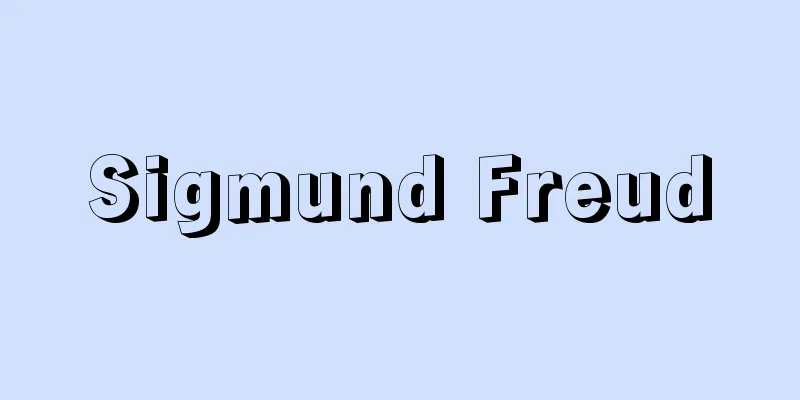Sigmund Freud

|
Austrian psychiatrist and founder of psychoanalysis. Born May 6th in Freiberg, Moravia (now Pribor, Czech Republic). His father was a Jewish wool merchant. He had two half-brothers, but was the eldest of eight children. He moved to Vienna at the age of four, but was in financial difficulty at the time. In 1874, he entered the University of Vienna. He first attended Brentano's lectures and was influenced by his ideas on intentionality. In his third year, he attempted to study neuroanatomy under Professor Ernst Wilhelm von Brücke (1819-1892). Unable to continue his academic life for financial reasons, he obtained his medical degree in 1881 at Brücke's urging, and the following year, in 1882, after his engagement to Martha Bernays (1861-1951), he began working at the Vienna General Hospital to gain financial stability. In 1885, he was appointed a private lecturer at the University of Vienna due to his research achievements on the conduction pathways of the medulla oblongata, and received a scholarship to study in Paris. He was so impressed by the treatment of hysteria using hypnosis and suggestion under Charcot that he translated the book into Japanese in 1886. He returned to Vienna and reported on the treatment he had observed under Charcot, but it was not accepted, so he became a private practitioner. Inspired by his senior neurologist Josef Breuer (1842-1925), he began using hypnotic treatment. In 1895, he wrote "Drafts on Psychology," which became the background of his later psychology (this draft was not published until 1950). Due to a suggestion from a patient during hypnotic treatment, he began using free association as an alternative method to hypnosis, and established psychoanalysis as a therapeutic technique. He began to interpret dreams analytically, and his theory became more developed. From that time (after 1902), people who were interested in Freud gathered around him (they called themselves the Psychological Wednesday Society), and in 1910 the International Psychoanalytic Association was formed. Jung was chosen as its first president, but Adler and Jung broke with Freud due to differences in their views on libido. He was persecuted by the Nazis, but in 1938 he fled to London with the help of Roosevelt and Mussolini. He died of maxillary cancer on September 23, 1939. [Daisaku Tonobayashi and Masamichi Kawabata] The Age of Unconscious PsychologyFreud's research achievements can be roughly divided into early and late periods, with the 1920 publication Beyond the Pleasure Principle as the dividing line. The early period is called depth psychology, while the latter is called ego psychology. The early ideas were based on his experience treating hysteria in the 1890s, and were conceived around the concept of repression. The works that best illustrate this way of thinking about the unconscious are The Interpretation of Dreams (1900), The Psychopathology of Everyday Life (1901), Three Essays on a Theory of Sexuality (1905), and Wit and its Relation to the Unconscious (1905). In 1915, he published a number of papers that attempted to theoretically summarize concepts such as impulse, repression, and the unconscious, and in the 1910s he began to write essays on Leonardo da Vinci's childhood memories, to analyze Daniel Paul Schreber's (1842-1911) medical history memoirs, and to attempt analytical interpretations of mental illnesses based on homosexuality. This interest was developed in his 1914 book "Introduction to Narcissism," but this idea was left unattended until his later period, when he wrote the essay "The Ego and the Id" in 1923. The difference between his early and later thinking is typically shown in the theory of place and the theory of drives. In his early theory of place, the apparatus of the mind is divided into consciousness, preconsciousness, and unconsciousness, but the underlying idea is to abandon the position of consciousness psychology, which tries to understand humans based on consciousness, and to assert that consciousness should be understood from the unconscious. This is in line with the phenomenology of the contemporary philosopher Husserl. [Daisaku Tonobayashi and Masamichi Kawabata] The Era of Ego PsychologyIn the later theory of place, it is considered from three levels (places): id (id), ego, and superego. Ist is a German impersonal pronoun, and roughly corresponds to the unconscious of the earlier period. It is possible to think of the ego as corresponding to consciousness and the superego as corresponding to the preconscious, but their meanings are completely different and take narcissism into consideration. As for the theory of drives, the earlier one is conceived from the ego drive for self-preservation and the sexual drive. However, this theory of drives does not mean a dualism of drives, but it is as if the self-preservation drive was assumed in order to derive the sexual drive. In this sense, it is sometimes called the pansexual theory. In the discussion of narcissism, the sexual drive (libido) is considered as object libido and ego libido, but in the later theory of drives, the self-preservation ego drive and the sexual drive are collectively called the life drive (eros), and the death drive (thanatos) is assumed in contrast to this. The idea of the death drive has been difficult for psychoanalysts to accept because of its unfamiliar connotation, but Freud had no other option. In terms of the terminology alone, it may seem that there are significant differences between the early and later periods, but in terms of Freud's thinking itself, a consistent analytical attitude can be seen. Clarifying this point is also a task for future Freud research. [Daisaku Tonobayashi] "The Collected Works of Freud", 11 volumes (1968-1984, Jinbun Shoin)" ▽ "The Selected Works of Freud", revised edition, 17 volumes (1969-1974, Nippon Kyobunsha)" ▽ "The Complete Works of Freud", 23 volumes (2006-, Iwanami Shoten)" ▽ "Freud's Last Diaries 1929-1939", edited by the Freud Museum, London, commentary and annotations by Michael Molnár, translated by Kobayashi Tsukasa (2004, Nippon Kyobunsha)" ▽ "Freud's Genealogy: The Development and Problems of Psychoanalysis", edited by J.A.C. Brown, translated by Utsugi Tamotsu and Ooba Hata (1963, Seishin Shobo)" ▽ "The Life of Freud, by Ernest Jones, translated by Taketomo Yasuhiko and Fujii Haruhiko (1964, Kinokuniya Shoten)" ▽ "Freud: Explorer of the Unconscious" by O. Mannoni, translated by Murakami Hitoshi (1970, Jinbun Shoin)" ▽ "Freud: The Man" by L. Marcuse, translated by Takahashi Yoshitaka and Takada Yoshishi (1972, Nihon Kyobunsha)" ▽ "Introduction to Freud" by Robert Welder, translated by Murakami Hitoshi (1975, Misuzu Shobo) ▽ "Freud: Opening the Doors of the Unconscious" by Pierre Babin, translated by Kobayashi Osamu (1992, Sogensha)" ▽ "Freud 1 & 2" by Peter Gay, translated by Suzuki Akira (1997, 2004, Misuzu Shobo)" ▽ "Illustrated: Freud: Archaeologist of the Mind" by Suzuki Akira (1998, Kawade Shobo Shinsha)" ▽ "Freud" edited by Okonogi Keigo (Kodansha Academic Library)" ▽ "Keywords of Freud's Thought" by Keigo Okogi (Kodansha Gendai Shinsho) [References] | | | | | | | | | | | | | | | | | | | | | |Source: Shogakukan Encyclopedia Nipponica About Encyclopedia Nipponica Information | Legend |
|
オーストリアの精神科医で、精神分析の創始者。5月6日、モラビアのフライベルク(現在のチェコのプリボール)に生まれる。父はユダヤ人で羊毛の商人。異母兄が2人いるが、8人兄弟の長子。4歳のときウィーンに移住するが、このころ経済的には困窮状況にあった。1874年ウィーン大学に入学。最初はブレンターノの講義に出席し、その志向性の考え方に影響を受ける。入学後3年目になりブリュッケErnst Wilhelm von Brücke(1819―1892)教授のもとで神経解剖学の研究を試みる。経済的理由で学究生活を続けることができず、ブリュッケの勧めで1881年に医学の学位をとり、翌1882年マルタMartha Bernays(1861―1951)との婚約で経済的な安定を得るためウィーンの総合病院に勤める。1885年、その間の延髄の伝導路に関する研究業績によりウィーン大学の私講師のポストを得、奨学金を得てパリに留学。シャルコーのもとでヒステリーの催眠・暗示による治療を見、大きな感銘を受けて1886年その著書を独訳する。ウィーンに帰りシャルコーのところで観察した治療法を報告するが受け入れられず、開業医となる。先輩の神経科医のブロイエルJosef Breuer(1842―1925)に刺激されて催眠による治療を始める。1895年には、後年の心理学の背景となっている『心理学の草稿』が書き上げられる(この草稿は1950年になって初めて公刊された)。催眠治療中の患者の示唆により、催眠にかわる方法として自由連想法を使うようになり、治療技術としての精神分析を確立する。夢の分析的解釈を始めるようになり理論的にも整ってくる。そのころ(1902年以降)からフロイトに関心を寄せる人たちがフロイトのもとに集まり(心理学水曜会と称する)、1910年国際精神分析協会が結成された。ユングを初代会長として選ぶが、アドラーやユングはリビドーの考え方の違いからフロイトと決別する。ナチスの迫害を受けるが、1938年ルーズベルトやムッソリーニなどの助力によってロンドンに亡命。翌1939年9月23日、上顎癌(じょうがくがん)で死亡した。 [外林大作・川幡政道] 無意識心理学の時代フロイトの研究業績は、大別して1920年の『快感原則の彼岸(ひがん)』を境にして前期と後期に分けられ、前期のものを深層心理学とよぶのに対して、後者は自我心理学とよばれている。前期の考え方は1890年代のヒステリーの治療経験に基づくもので、抑圧の概念を中心にして構想されたものである。こうした無意識の考え方をもっともよく示しているものは1900年の『夢判断』、1901年の『日常生活の精神病理学』、1905年の『性理論のための三篇(へん)』『機知――その無意識との関係』などである。1915年になると衝動、抑圧、無意識などの概念を理論的にまとめようとする諸論文が公刊されるが、1910年代には、レオナルド・ダ・ビンチの幼児記憶についての論考をはじめ、シュレーバーDaniel Paul Schreber(1842―1911)の病歴の回想録の分析的論考を試み、同性愛をもとにして精神病の分析的解釈を試みるようになる。こうした関心は1914年の『ナルシシズム入門』に展開されるが、この考え方は、後期に入り、1923年の『自我とエス』の論文が書かれるまで放置されたままになったものである。前期と後期の考え方の違いは、場所論と衝動論に典型的に示されている。前期の場所論では、心という装置は意識、前意識、無意識に分けられるが、この根底をなしている考え方は、意識をもとにして人間を理解しようとする意識心理学の立場を捨てて、意識は無意識から理解されるべきものであることを主張しようとするものである。これは同時代の哲学者フッサールの現象学と軌を一にするものである。 [外林大作・川幡政道] 自我心理学の時代後期の場所論では、エス(イド)、自我、超自我の三つの審級(場所)から考えられる。エスはドイツ語の非人称の代名詞であるが、およそのところ前期の無意識に対応するものである。しいていえば自我は意識に、超自我は前意識に対応させて考えられないこともないが、その意義はまったく異なり、ナルシシズムを考慮に入れたものである。衝動論についていえば、前期のものは自己保存の自我衝動と性衝動から構想されている。しかし、この衝動論は衝動の二元論を意味するものではなく、性衝動を導き出すために自己保存の衝動が仮定されたようなものである。この意味で汎(はん)性欲説といわれることがある。ナルシシズムの論考では、性衝動(リビドー)は対象リビドーと自我リビドーとして考えられるようになるが、後期の衝動論では、自己保存の自我衝動と性衝動を包括して生の衝動(エロス)とよび、これに対して死の衝動(タナトス)が仮定されるようになる。死の衝動という考え方は親しみにくい語感をもつために、精神分析家にも容易に受け入れられないものであったが、フロイトにいわせれば、これ以外には考えようのないものであった。用語の違いだけからいえば前期と後期ではかなりの相違があるように考えられるかもしれないが、フロイトの考え方そのものからいえば一貫した分析的態度が認められる。その点を明らかにすることが今後のフロイト研究の課題でもある。 [外林大作] 『『フロイト著作集』全11巻(1968~1984・人文書院)』▽『『フロイド選集』改訂版・全17巻(1969~1974・日本教文社)』▽『『フロイト全集』全23巻(2006~・岩波書店)』▽『ロンドン・フロイト記念館編、マイクル・モルナール解説・注、小林司訳『フロイト最後の日記 1929~1939』(2004・日本教文社)』▽『J・A・C・ブラウン編、宇津木保・大羽秦訳『フロイドの系譜――精神分析学の発展と問題点』(1963・誠信書房)』▽『アーネスト・ジョーンズ著、竹友安彦・藤井治彦訳『フロイトの生涯』(1964・紀伊國屋書店)』▽『O・マノーニ著、村上仁訳『フロイト――無意識の世界の探求者』(1970・人文書院)』▽『L・マルクーゼ著、高橋義孝・高田淑訳『フロイト――その人間像』(1972・日本教文社)』▽『ロバート・ウェルダー著、村上仁訳『フロイト入門』(1975・みすず書房)』▽『ピエール・ババン著、小林修訳『フロイト――無意識の扉を開く』(1992・創元社)』▽『ピーター・ゲイ著、鈴木晶訳『フロイト1・2』(1997、2004・みすず書房)』▽『鈴木晶著『図説 フロイト――精神の考古学者』(1998・河出書房新社)』▽『小此木啓吾編『フロイト』(講談社学術文庫)』▽『小此木啓吾著『フロイト思想のキーワード』(講談社現代新書)』 [参照項目] | | | | | | | | | | | | | | | | | | | | | |出典 小学館 日本大百科全書(ニッポニカ)日本大百科全書(ニッポニカ)について 情報 | 凡例 |
>>: Prussian constitutional dispute (English: Verfassungskonflikt) German
Recommend
Concertina (English spelling)
A small accordion. A type of aerophone instrument....
Massey
Massé is a billiards technique in which the player...
America Cup
…In the 19th century, it developed into a high-en...
Large butterfly fly - Large butterfly fly
...Adults can often be seen spinning around on gl...
Gamla Staden (English spelling)
… The city center is an area of about 1 km squa...
Perfect era
...As a result of sexual reproduction, ascus are ...
Omura clan
Lord of Omura Domain in Hizen Province. It is sai...
Sublimation - Showa
〘noun〙① When a solid becomes gas directly without ...
Reizei-in Temple
Built by Emperor Saga during the Kōnin era (810-8...
Harmonium
A keyboard instrument that produces sound by blowi...
Waverly - Waverly
…His literary fame increased with romantic narrat...
Flexible Support - Kakussei
…These are examples of tunnel supports at the fac...
Pufferfish (blowfish) - Pufferfish
In the Kansai region and west, it is also called f...
Ministry of Finance, Monopoly Bureau
…As of March 1983, the company's capital was ...
Carbylamine reaction - Carbylamine reaction
…When heated, it isomerizes to produce a nitrile,...









